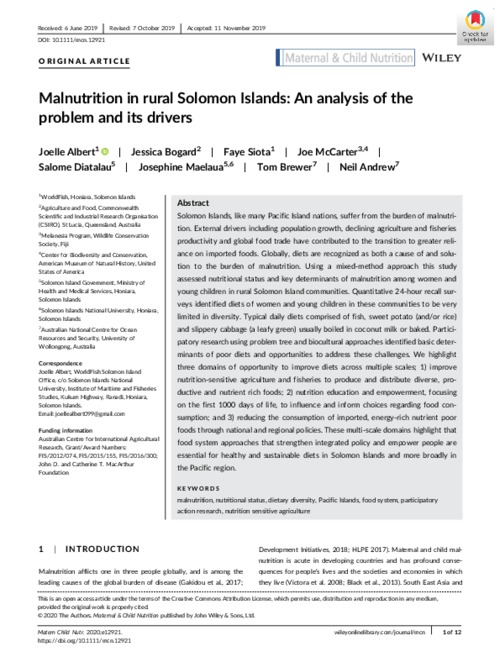Malnutrition in rural Solomon Islands: An analysis of the problem and its drivers

Solomon Islands, like many Pacific Island nations, suffer from the burden of malnutrition. External drivers including population growth, declining agriculture and fisheries productivity and global food trade have contributed to the transition to greater reliance on imported foods. Globally, diets are recognized as both a cause of and solution to the burden of malnutrition. Using a mixed‐method approach this study assessed nutritional status and key determinants of malnutrition among women and young children in rural Solomon Island communities. Quantitative 24‐hour recall surveys identified diets of women and young children in these communities to be very limited in diversity. Typical daily diets comprised of fish, sweet potato (and/or rice) and slippery cabbage (a leafy green) usually boiled in coconut milk or baked. Participatory research using problem tree and biocultural approaches identified basic determinants of poor diets and opportunities to address these challenges. We highlight three domains of opportunity to improve diets across multiple scales; 1) improve nutrition‐sensitive agriculture and fisheries to produce and distribute diverse, productive and nutrient rich foods; 2) nutrition education and empowerment, focusing on the first 1000 days of life, to influence and inform choices regarding food consumption; and 3) reducing the consumption of imported, energy‐rich nutrient poor foods through national and regional policies. These multi‐scale domains highlight that food system approaches that strengthen integrated policy and empower people are essential for healthy and sustainable diets in Solomon Islands and more broadly in the Pacific region.
Permalink
Date Available
Type
Publisher
Countries
ISSN
1740-8695
Copyright
CC-BY-4.0
Research Themes
Topics
Language